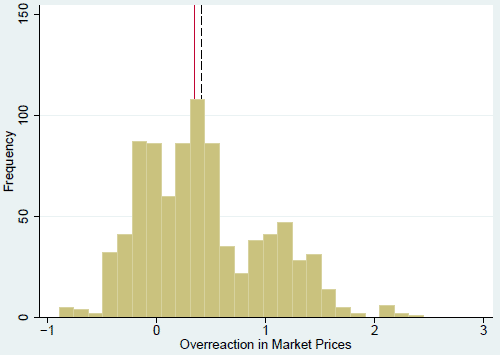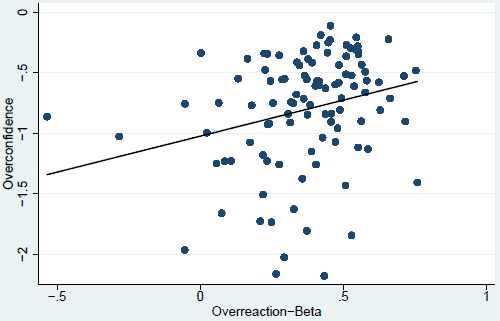Is overreaction pervasive? Is it resistant to learning, or does experience temper it? Is overconfidence a driver of overreaction? How does overreaction affect portfolio performance? Two related July 2009 papers entitled “Overreaction in Stock Forecasts and Prices” by Alen Nosic and Martin Weber and “Overreaction and Investment Choices: An Experimental Analysis” by Bruno Biais, Alen Nosic and Martin Weber tackle these questions experimentally. Using somewhat informed university students as subjects, they conclude that:
“Overreaction in Stock Forecasts and Prices” measures the degree of individual and aggregate market overreaction in an experimental stock market. Experimenters give participants six-month stock price charts of two related stocks (G and H) and ask them to forecast the price of stock H after six additional months. Participants are then allowed to trade stock H. Experimenters then give participants additional information about stock G and ask them to update their forecasts for the price of stock H in six months. Participants may then trade stock H again. Each participant goes through these steps for eight pairs of stocks. Comparing the results from this experiment across 101 participants to theoretically rational forecasts based on Bayesian updating, the authors conclude that:
- Participants tend to overreact to new information, both good and bad, in their stock price forecasts and transaction prices. Although there are instances of underreaction, almost all participants overreact on average.
- The market in aggregate also tends to overreact in transaction prices (see the first chart below). In other words, market forces do not compensate for individual biases.
- The degree of overreaction is stable over time, suggesting that experience does not extinguish overreaction bias.
- Divergence of opinion on a stock relates positively to trading volume.
The following histogram, taken from the paper, summarizes the aggregate degree of overreaction in market prices. The dashed black (solid red) line indicates the the mean (median) value of the distribution. 637 transactions occur at overreacting prices, while only 232 transactions are at underreacting prices. There is considerable variation in degree of overreaction across participants and stocks. [The scale of overreaction does not translate simply to a percent overvaluation.]

“Overreaction and Investment Choices: An Experimental Analysis” examines the degree of overreaction, the relationship between overreaction and overconfidence and the portfolio impacts of overreaction based on responses of participants to a questionnaire. For 20 pairs of stocks with pairs related by industry, the questionnaire shows participants the price path of one of a pair (G) for the whole year and the price path of the second of the pair (H) for only the first half of the year. The questionnaire then asks participants to forecast the price of H at the end of the year, along with upper and lower bounds for a 90% confidence level. The questionnaire then asks participants to allocate hypothetical portfolio funds either to forecasted stocks or cash. The authors measure overreaction and overconfidence based on deviation of participant forecasts/bounds from those developed via theoretically rational Bayesian updating. Based on the results from this experiment for 104 participants, the authors conclude that:
- About 90% of participants overreact on average in forecasting the 20 stock prices.
- In aggregate, by setting bounds too tight, participants exhibit a substantial degree of overconfidence in upper and lower forecast bounds.
- The level of overreaction relates positively to the level of overconfidence. In other words, Participants who are more overconfident overreact more (see the chart below).
- Overreaction relates positively (negatively) to portfolio volatility after positive (negative) signals. In other words, overreaction in price outlook translates to risk mismanagement.
- Overreaction relates negatively to portfolio efficiency, as measured by the Sharpe ratio. In other words, overreaction harms portfolio performance.
The following scatter plot, taken from the paper, characterizes the relationship between participant overconfidence and overreaction in stock valuation. While the modeled relationship is positive, there is considerable variation in the relationship across participants and stocks. [The scale of overreaction does not translate simply to a percent overvaluation.]

In summary, evidence from experimental tests indicates that investor/trader overreaction probably is pervasive, partly driven by overconfidence and not subject to moderation through learning. Overreaction tends to elevate portfolio volatility and reduce portfolio Sharpe ratio.
Strength of this evidence is of course constrained by artificialities in the experiments.